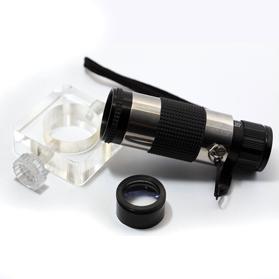Getting the best from your D-D NanoScope
On many occasions we may wish to observe a coral or other form of aquatic life in close up detail. Occasionally we may need to diagnose a problem, look for possible pests or infections, or simply observe the anatomy and function of an animal at very close quarters to better understand its requirements.
The NanoScope offers us this opportunity without the need in most cases to remove the animal, be it coral, fish or even reptile, from its existing position or environment. This limits stress, and in the case of corals, excessive mucus secretion from exposure to air that could otherwise disguise some pests making detection more difficult.

To get the best results from your NanoScope it is advised that the following guidelines are taken into account.
When viewing objects at such high magnification, very small changes in relative position of the instrument compared to the subject (hand shake)can lead to difficulty in focusing or maintaining constant focus. It is therefore advised that whenever possible the unit is mounted in such a manner that the front lens is touching against the aquarium glass to minimise the chances of movement or judder. Alternately mount the NanoScope to a secure object in front of the aquarium such as a tripod.
The two lenses supplied with the NanoScope provide two differing levels of magnification, over two different focal lengths(Focal Length is the workable range of distance over which a particular lens will focus). See the image below.
The standard pre attached lens offers a magnification of x8. The usable focal range through water when measured from the front of the lens is from 315mm(focus barrel screwed fully out) to infinity(focus barrel screwed fully in).With this lens it is not possible to focus on objects any closer to the lens than 315mm unless the NanoScope is moved backwards away from the aquarium glass to maintain the minimum focal distance from the subject.

The additional 24-48x macro lens can be screwed into the front of the standard lens to offer a significantly higher level of magnification for extremely close inspection. As such, similar to the macro lens of a camera, it has a much smaller range of focus.
With the macro lens, when viewing objects through water, the subject must be positioned between a minimum distance from the front of the NanoScope of 70mm (focus barrel screwed fully out), to a maximum distance of 100mm(focus barrel screwed fully in). This gives a total focal range of 30mm. With the macro lens it is therefore not possible to focus on objects in your aquarium which are any closer than 70mm unless the NanoScope itself is moved backwards away from the aquarium glass to maintain the minimum focal distance.
*In some situations it may be necessary to move a coral or other subject closer to the aquarium viewing pane if observation using the macro lens is required.

Additional notes:
Due to potential cloudiness caused by the cumulative effects of suspended bubbles or particulates in typical aquarium water we have restricted the focal range for the macro lens to close up work to ensure that you acquire images with a high degree of clarity.
When using the standard 8x lens at lower magnification, objects at the rear of the aquarium can be viewed clearly without any such interference.
Use in air:
It should be noted that the focal ranges shown above will differ when an object is viewed without the refractive properties of water.
When viewing through air, the following minimum and maximum ranges will apply.
Standard 8x lens focal range: 240mm to infinity.
Additional 24-48x macro lens focal range: 55-75mm
Using the guide above, we hope you will get the very best from your new D-D NanoScope.
Images taken using Canon EOS500D with standard EFS 18-55mm lens
